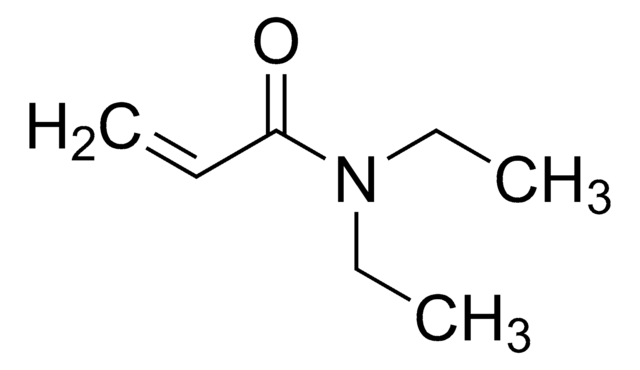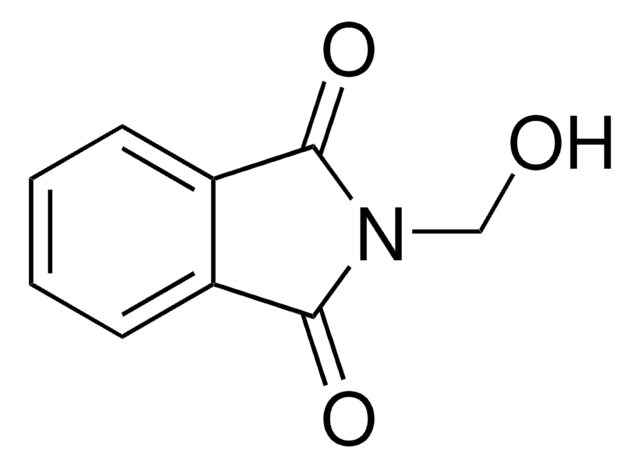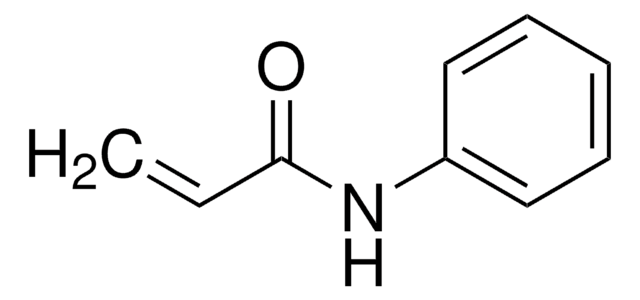Products may be shipped at a different temperature than the recommended long-term storage temperature. If the product quality is sensitive to short-term exposure to conditions other than the recommended long-term storage, it will be shipped on wet or dry-ice. If the product quality is NOT affected by short-term exposure to conditions other than the recommended long-term storage, it will be shipped at ambient temperature. As shipping routes are configured for minimum transit times, shipping at ambient temperature helps control shipping costs for our customers. For more information, please refer to the Storage and Transport Conditions document: https://www.sigmaaldrich.com/deepweb/assets/sigmaaldrich/marketing/global/documents/316/622/storage-transport-conditions-mk.pdf
245801
N-(Hydroxymethyl)acrylamide solution
48 wt. % in H2O
Synonym(s):
Monomethylolacrylamide, N-(Hydroxymethyl)acrylamide, N-Methanolacrylamide
About This Item
Recommended Products
form
liquid
contains
30 ppm monomethyl ether hydroquinone as inhibitor
concentration
48 wt. % in H2O
refractive index
n20/D 1.413
density
1.074 g/mL at 25 °C
SMILES string
OCNC(=O)C=C
InChI
1S/C4H7NO2/c1-2-4(7)5-3-6/h2,6H,1,3H2,(H,5,7)
InChI key
CNCOEDDPFOAUMB-UHFFFAOYSA-N
Looking for similar products? Visit Product Comparison Guide
General description
Application
- A monomer in the development of polymer gel dosimeters specifically designed for radiation therapy applications. The incorporation of NHMA enhances the sensitivity of the dosimeter to radiation doses.
- A monomer in the development of thermo-responsive polymeric gates, which exhibits thermo-responsive behavior. The incorporation of NHMA enhances the overall properties of the polymer, allowing for better control over the release mechanisms in response to temperature changes.
- A key monomer in the synthesis of double-hydrophilic and amphiphilic block glycopolymers, contributing to their self-assembly properties, biocompatibility, and functionalization potential. These characteristics make NHMA-based glycopolymers valuable for various biomedical applications, including drug delivery systems, biosensors, and tissue engineering.
Signal Word
Danger
Hazard Statements
Precautionary Statements
Hazard Classifications
Acute Tox. 3 Oral - Carc. 1B - Muta. 1B - Repr. 2 - Skin Sens. 1 - STOT RE 1 - STOT RE 2 Oral
Target Organs
Peripheral nervous system
Storage Class Code
6.1D - Non-combustible acute toxic Cat.3 / toxic hazardous materials or hazardous materials causing chronic effects
WGK
WGK 3
Flash Point(F)
Not applicable
Flash Point(C)
Not applicable
Personal Protective Equipment
Choose from one of the most recent versions:
Already Own This Product?
Find documentation for the products that you have recently purchased in the Document Library.
Customers Also Viewed
Articles
Professor Mitsuhiro Ebara provides insights on several types of smart nanofiber mesh systems that have been explored for different drug delivery purposes.
-
How is shipping temperature determined? And how is it related to the product storage temperature?
1 answer-
Helpful?
-
-
How can I determine the shelf life / expiration / retest date of this product?
1 answer-
If this product has an expiration or retest date, it will be shown on the Certificate of Analysis (COA, CofA). If there is no retest or expiration date listed on the product's COA, we do not have suitable stability data to determine a shelf life. For these products, the only date on the COA will be the release date; a retest, expiration, or use-by-date will not be displayed.
For all products, we recommend handling per defined conditions as printed in our product literature and website product descriptions. We recommend that products should be routinely inspected by customers to ensure they perform as expected.
For products without retest or expiration dates, our standard warranty of 1 year from the date of shipment is applicable.
For more information, please refer to the Product Dating Information document: https://www.sigmaaldrich.com/deepweb/assets/sigmaaldrich/marketing/global/documents/449/386/product-dating-information-mk.pdfHelpful?
-
Active Filters
Our team of scientists has experience in all areas of research including Life Science, Material Science, Chemical Synthesis, Chromatography, Analytical and many others.
Contact Technical Service



![N-[Tris(hydroxymethyl)methyl]acrylamide contains ≤7% KCl, 93%](/deepweb/assets/sigmaaldrich/product/structures/130/961/5bc6d1a4-a540-4496-9f46-74507af67e21/640/5bc6d1a4-a540-4496-9f46-74507af67e21.png)









